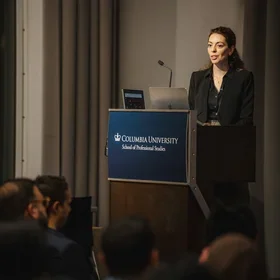Lekshmi Geetha, head of people, India, for Snap Inc., joined Steve Safier and Laura Guerrieri’s fall 2022 Integrated Talent Management class to discuss the power (and the challenges) of matrix organizations. Integrated Talent Management Strategies is a core course in Columbia’s M.S. in Human Capital Management program; students learn how to analyze organizational processes for talent retention; evaluate best-practices for selecting, developing, and maintaining talent within an organization; and assess the role of technology in enabling integrated talent solutions.
Geetha shared how matrix organizations enable companies to focus on a geography, business, or function while supporting collaboration. But without careful support, managers can open themselves up to conflict among team members trying to satisfy competing objectives.
Geetha explained that when a company wants to enter a new market, it can leverage a functional corporate office to set the new strategy, but equally important is strong local knowledge of processes, the local market, and unique cultures.
Clients are better served with the “best of both”—global and local understanding. She gave an example of a streaming service in India where a corporate creative team partners with the production team on the ground to hire local talent as well as ensure the content resonates with Indian audiences.
Matrixed organizations, however, face their fair share of challenges in supporting the timely flow of information and in aligning what may be competing objectives at different points of the organization.
Successful matrixed organizations have cultures of open and transparent communication, where leaders trust and rely on cross-functional partnerships. They invest in building collegial relationships focused on shared goals. They also embrace the conflict inherent in the matrix to produce better outcomes. For example, employees are given platforms to discuss, debate, and align in various cross-functional and skip-level meetings and use tools (e.g., Google Docs) to collect input and build consensus.
On a personal note, Geetha told the class that she built her career as an HR leader by workingclosely with her business partners to build talent. She also offered this perspective: “A lot of business problems are linked to HR,” she said. “As HR professionals, yourunderstanding of the business and of various ways to diagnose and solve business challenges will contribute positively to your overall impact. It’s worked well for me; I’ve learned the business well before jumping into my role in HR.”




